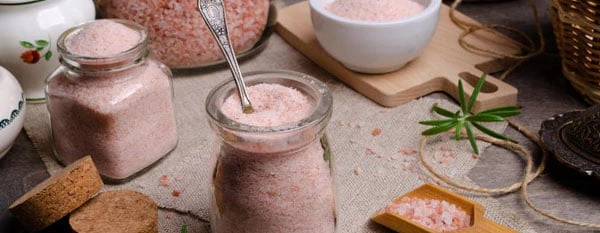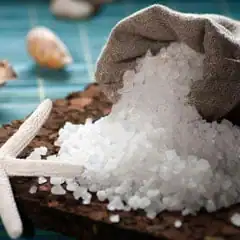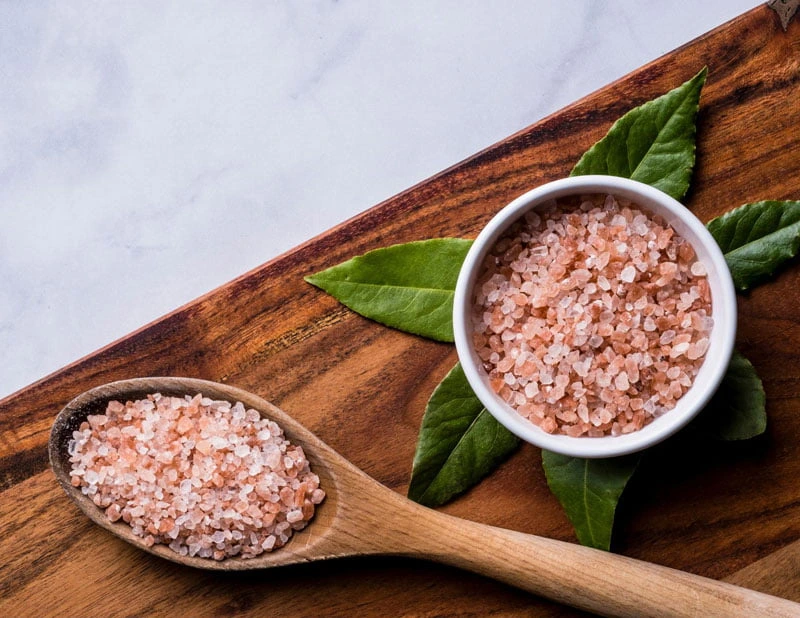Pink Himalayan salt is a popular alternative to regular table salt, known for its distinctive pink color and potential health benefits. But does it taste different from table salt?
Many salt aficionados think it has a slightly milder, less salty flavor than regular table salt, although some people may not be able to detect a significant difference in taste.
Whether you’re a “seasoned” chef or a home cook looking to experiment with new flavors or just curious about that bottle of pink salt on the grocery store shelf, this post will give you a better understanding of the taste of Himalayan salt and how it can be incorporated into your cooking.

How Does The Taste of Himalayan Salt Compare to Regular Table Salt?
In general, the taste of Himalayan pink salt is likely to be similar to other types of rock salt, such as sea salt or kosher salt since all of these form of salt primarily consist of Sodium Chloride. Himalayan Pink salt contains small amounts of several minerals and trace amount of dozens more, so that informs the flavor that some people derive from it. It is thought to have a more complex, slightly earthy flavor, although this may be subjective.
I find it to have a milder and slightly more interesting flavor than regular table salt. Common table salt can have an almost harsh taste if it is not first mixed into prepared food. The perceived flavor difference can vary depending on the specific source and processing method of each of the salts you are comparing.
Ultimately, the taste of Himalayan salt is a matter of personal preference, and some people may prefer the taste of regular table salt or other types of salt. One possible reason for this is that Himalayan salt is generally purchased in coarser particles and regular table salt is ground fine, which may have a slightly less intense saltiness when sampled.
Any Noticeable Differences in the Flavor of Himalayan Salt From Different Sources or Processing Methods?
Like any food product, the flavor of Himalayan pink salt may vary depending on the source and processing method. Generally, Himalayan salt is mined from ancient sea beds in the Himalayan Mountains, and the flavor of the salt can be influenced by the minerals and other substances in the surrounding rock.
The method of processing can also affect the flavor of Pink salt. Some manufacturers use more refined methods to remove impurities and produce a more consistent product, while others may use more traditional or artisanal methods that preserve more of the natural minerals and texture of the salt.
Some people may be able to detect differences in taste, while others may not notice any significant differences. Ultimately, the flavor of Himalayan salt may depend on individual taste preferences and the specific characteristics of the salt.
For more about Himalayan Salt, the various colors that it comes in, and how that affects the taste of the salt, see our article Taste The Rainbow: How The Color Of Himalayan Salt Affects Its Flavor.
Can Himalayan Salt Be Used in Place of Regular Salt in Cooking and Baking?
Himalayan salt can generally be used in place of regular salt in cooking and baking, although it may have some unique flavor properties that make it better suited for certain dishes.
One important thing to consider when using it is that it has a coarser grain size, which may affect the way it dissolves and distributes flavor in a dish. Since it may not dissolve as quickly as regular table salt, it may be best suited for dishes where the salt is used as a finishing touch or where it can be fully dissolved before consuming, such as in a brine or marinade.
Himalayan salt can be used in place of regular salt in most dishes, although it may be best to start with a smaller amount and adjust to taste. It may also be worth experimenting with it in dishes where its unique flavor properties can be highlighted, such as in seasoning blends or as a finishing touch for grilled meats or roasted vegetables.
Since Himalayan Pink Salt tends to cost 2x to 5x as much as an equivalent weight of table salt, I tend to use the lesser expensive common salt in recipes or when salting the pasta water. When cooking dishes like potatoes or vegetables, I will use about half the normal amount of table salt during preparation, and then I will sprinkle just a bit of Pink Himalayan Salt on top of the dish as a finishing salt. On food like fried or poached eggs, I save the pink salt for the topping – and no other salt is needed in the food preparation.
Does Himalayan Salt Taste Different than Sea Salt or Kosher Salt?
The taste of Himalayan salt is largely considered to be similar to other types of rock salt, such as sea salt and kosher salt. All of these types of salt are derived from natural sources, and their flavors may be influenced by the minerals and other substances present in the surrounding rock. If you’d like to learn more about those minerals, please see our article: Minerals In Himalayan Salt: Let’s See What’s In There.
That being said, there may be some slight differences in the taste of Himalayan salt compared to other types of rock salt. For example, Himalayan salt is known for its distinctive pink color, which is due to the presence of trace minerals such as iron, magnesium, and calcium…these minerals may contribute to its unique flavor. Kosher Salt does not tend to have the same mineral content, so it will taste a little more ‘flat’ than Himalayan Salt.
Sea Salt is a pretty generic term, so it is hard to characterize the flavor. A sea salt in a cardboard container from the grocery store is going to be different than some thing like Celtic Sea Salt or Fleur de Sel. We do a bit more of a ‘deep dive’ comparing Himalayan vs Sea Salt in this article: Himalayan vs Sea Salt: Which One Reigns Supreme.

Sea salt comes from evaporated seawater and may have a slightly brinier, more complex flavor. Once again, the answer really depends on what kind of Sea Salt from what source and what type of processing.
Kosher salt is typically more coarse and flaky, and it is often used in koshering meat due to its ability to draw out moisture.
Are There Any Health Benefits to Using Himalayan Salt Over Regular Salt?
There are some claims that Himalayan salt may have certain health benefits compared to regular salt, although scientific evidence for these claims is limited and more research is needed. Some of the purported benefits of Himalayan salt include:
- Higher Mineral Content – Himalayan salt is believed to contain higher levels of minerals such as iron, magnesium, and calcium, which may be beneficial for certain health conditions or for general health. The actual amount of these minerals in Himalayan salt is small, and it is not clear whether they provide any significant health benefits when consumed in small amounts.
- Lower Sodium Content – The sodium content of Himalayan salt is generally similar to that of regular table salt, and it is not a suitable replacement for individuals on a low-sodium diet. You may be able to reduce your overall consumption of sodium by using less salt while doing food preparation and then using only a small amount of Himalayan salt on the top of the food.
- Improved Taste And Flavor – Some people claim that Himalayan salt has a more complex, slightly earthy flavor than regular salt, which may make it a healthier alternative for people who want to reduce their salt intake. However, this is subjective and may depend on individual taste preferences.
I wasn’t able to find any scientific studies that validated the health benefits of pink salt. However, I did find one interesting study that compared 31 different brands of Himalayan or simply ‘pink salt’ that were available for sale in Australia, and they analyzed the trace mineral content in each of the samples. If that is of interest, you can find it here.
So the health benefits some claim may be exaggerated and you should always take the advice of your doctor. While it may contain higher levels of minerals and have a slightly different flavor, it is not a substitute for a healthy diet and should be consumed in moderation as part of a balanced diet. Also note that Himalayan salt is not considered to be a significant source of Iodine. If you’d like to learn more about Iodine in salt, please see our article Details On Iodine In Himalayan Salt: What You Need To Know.
Final Thoughts
The coarser grain size of Himalayan salt may affect the way it dissolves and distributes flavor in a dish, and it may be best suited for dishes where it can be fully dissolved before consuming or where it can be used as a finishing salt. The unique flavor profile of Himalayan salt may also make it a good choice for seasoning blends or as a finishing touch for grilled meats or roasted vegetables. Pink Himalayan salt may be just the thing to add an interesting accompaniment to your food!







